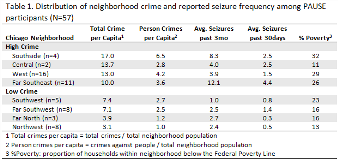PWE From Underserved Populations Living in High Crime Neighborhoods Have Higher Seizure Frequency: PAUSE to Learn Your Epilepsy
Abstract number :
2.425
Submission category :
17. Public Health
Year :
2018
Submission ID :
502144
Source :
www.aesnet.org
Presentation date :
12/2/2018 4:04:48 PM
Published date :
Nov 5, 2018, 18:00 PM
Authors :
Jessica Levy, University of Illinois at Chicago; Katharine Ozenberger, University of Illinois at Chicago; and Dilip Pandey, University of Illinois at Chicago
Rationale: Perceived stress is often considered a trigger for people living with epilepsy (PWE) and neighborhood violence and crime represents a significant environmental stressor. There is a lack of understanding of the association between environmental stressors and seizure aggravation. Violence and crime have significant geographical variation and are often correlated with socio-economic factors. No known study has investigated the relationship between violence and crime in Chicago neighborhoods with the seizure frequency and epilepsy severity. Methods: The PAUSE to Learn Your Epilepsy study evaluates the effectiveness of personalized self-management education using mobile technology on improving the lives of adult PWE from underserved populations. Participants who live in the city of Chicago (N=57) were collapsed into geographically determined neighborhoods using zip codes recorded at baseline. Crime type and rates within the past year were collected from the City of Chicago Police data portal. Two cumulative crime statistics for crimes committed outside the home were calculated: Crimes against people and Total crime. Crimes against people represent a sum of crimes classified as: Homicide (1st and 2nd degree), involuntary manslaughter, criminal sexual assault, aggravated assault, aggravated battery, simple assault, simple battery, and criminal sexual abuse. Total crime is a sum of crimes against people, as well as arson, stolen property, vandalism, robbery, larceny, motor vehicle theft, burglary, weapons violation, prostitution, drug abuse, and disorderly conduct. Two index variables were created: Total crimes per capita (total crimes divided by total neighborhood population) and Crimes against people per capita (crimes against people divided by total neighborhood population). The four neighborhoods with the highest crime index were considered to be high crime, while the remaining four were considered to be low crime. Seizure frequencies within the past 30 days and past 3 months were collected at baseline and were examined using a t-test. Results: PWE living in the four high crime neighborhoods within the City of Chicago reported the highest level of seizure frequency (Table 1). Those living in high crime neighborhoods, on average, had higher seizure frequency compared to those living in low-crime neighborhoods: 3.1 vs. 1.0 seizure in the past 30 days (p < 0.01) and 8.2 vs. 2.3 seizures in the past 3 months (p < 0.01). Though these neighborhoods also have a high proportion of households with income below the Federal Poverty Line, there is no overall association between seizure frequency and neighborhood poverty. Conclusions: PWE who live in high crime neighborhoods within the City of Chicago are exposed to a higher degree of environmental stressors that may be associated with their higher frequency of seizures. Understanding the association between violence and crime as a potential trigger for seizures allows us to make better informed recommendations for self-management education and stress management skills Funding: PAUSE is a project supported by the University of Illinois Prevention Research Center and the Centers for Disease Control and Prevention's MEW Network. The project is administered by the Institute for Health Research and Policy of the University of Illinois at Chicago, under CDC cooperative agreement no. U48-DP005010.
